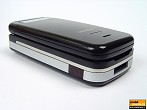Siemens SF65 review: Joint venture
Siemens SF65 is an elegant clamshell phone of a modern design, a spinning display and a megapixel camera. The construction, though, has been taken over from Philips, which comes to reveal that this brand's favorers are to expect a lot of changes and surprises.
Car manufacturers merge into big multinational corporations. They use the same components to create several models of different car makes for the purpose of lowering the expenses on production. The automobiles produced in this way have more or less the same parts. What differentiates them, though, is the design, which is to meet the requirements of the make given.



![]()

Official photos of Siemens SF65
Such practice has already become standard for the mobile phones business as well. The new Siemens SF65 works on the same constructional principles like Philips 760. Both telephones are equally equipped with the outlook being the only feature that differentiates them. A quick glance is enough to reveal that this phone has been developed in Philips' workshops and that the only job Siemens did was to design cover versions and user's environment of its own.
Key benefits
- Stylish design and a construction with a spinning display
- A very good quality megapixel camera
- TFT display, 128 × 160 pixels, 65K colors
- Built-in 21 MB memory
Main drawbacks
- No character counter when writing SMS
- No video recording
- A second small display would have come in handy
- No MP3 support
- No Bluetooth support
Apple is an inspiration
One would hardly deny that the new Siemens' SF65 elegancy is remarkable. The even glossy covers with their slightly oval edges and decently embedded elements give the strong impression of an integrated and compact device. There is no doubt that this smallish cuboid will become a thorn in the flesh of many manufacturers of luxurious and stylish mobile phones for this is the first time that Siemens makes a serious step into their "territory". Nevertheless, it once again proves the old statement that power comes with simplicity.
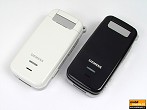


Simply elegant; we got both color versions of the telephone
The phone is going to be launched in two color versions - black and white; just like the music player Apple iPod, whose design may have served as an inspiration for Siemens developers. The famous designer Ora Ito has also let himself get inspired by the same device when creating the new Sagem myX-8. To cut a long story short, the "ala apple" design is cool these days.



The even white surface is "cool". Nor is the black one to be flung away...
When closed, the new Siemens takes up space of 91 × 41 × 23 mm and weighs 97 g and thus fits into the common average class of mobile phones. Its cuboid form has been carefully elaborated with the edges being slightly round. Under the detachable cover, which actually serves as the phone's back cover, you will find a Li-Ion battery of 660 mAh capacity, which is expected to supply the phone with energy for up to 240 minutes of calling and up to 400 hours when in a standby mode. Unfortunately, we did not have the opportunity to test phone's real durability time, but according to our first establishments it must be quite tolerable - do not forget that it is a dressed up Philips we have the honor to deal with.


The phone is quite small • back cover constitutes the whole rear side of the phone
The construction gives a solid general impression. No creaky sounds were to be noticed when opening the clamshell or spinning the display and the moving portion would always gently bottom when closing the phone. However, when I constricted the device, the front and the rear covers gave out some quite unpleasant sounds.
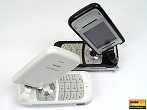
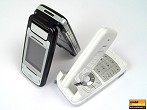

Just like a sunflower following the sun... • A detail of the spinner hinge
The majority of all Philips clamshells suffer from a bit strange infirmity - the display portion is usually so heavy that it does not allow the phone to stay still on its bottom part when in an open mode and it outbalances easily. The new Siemens SF65 is no exception from this rule.

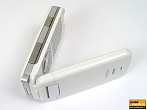

The telephone balancing on the edge • Construction is remarkably firm
No outer display
Thanks to its spinner form factor the display can stay on view even if the phone is closed. Nothing of a new solution on the market with mobile devices for LG T5100 or Nokia 6260, for example, can already show off with this. In the case of Siemens' new model, however, the reversed display is usable in the camera mode only. By just reversing the display the phone mode gets automatically switched off and the camera mode gets activated. It is a pity though. Provided my phone is lying closed on the table, I would embrace the chance to check what time it is or whether a message has been received.



The diode and the loudspeaker slot hole • The display turned inside out.. • ..and classically closed
It is the information diode mounted on the front cover that is supposed to serve for quick checking of the missed calls or short messages. It does starts blinking (with a green and red light) when the phone is ringing or when a SMS has been received, but yet after having gone out, it stays dark for long four and a half minutes. Then it blinks for several seconds again and repeatedly takes a long break off. As a result, it is only by chance that one happens to notice a missed call or message.
 That is how the diode blinks, regrettably not strongly enough
That is how the diode blinks, regrettably not strongly enough
The front cover is totally smooth and glossy. The black version is especially impressive and therefore lures to finger games or makes you constantly rub the phone against your T-shirt. Besides the information diode here you will also find a small slot hole for the loudspeaker as well as the manufacturer's logo. At the top part of the cover there is a small chromium-plated area having no other function but the one of a design accessory.
The rear side is completely smooth likewise. It is decorated with the manufacturer's logo as well as by the camera's lens surrounded by a big circle frame, in which a diode for supplementary lighting is mounted.


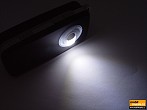
Camera with a diode for supplementary lighting placed on the rear side of the telephone
The side parts are decorated with a narrow chromium-plated stripe, the right side one of which is complemented by two volume buttons and the camera's release button. On the left side there are no buttons except for the infrared port at the bottom. A silver strip runs along the whole circumference of the phone interfered with by the system connector at the bottom part. The latter is the same like in the rest of Siemens' phones of Class 60. At the right upper corner a solid eye stands out for a stripe to be handled.
Reader comments
Nothing yet. Be the first to comment.




